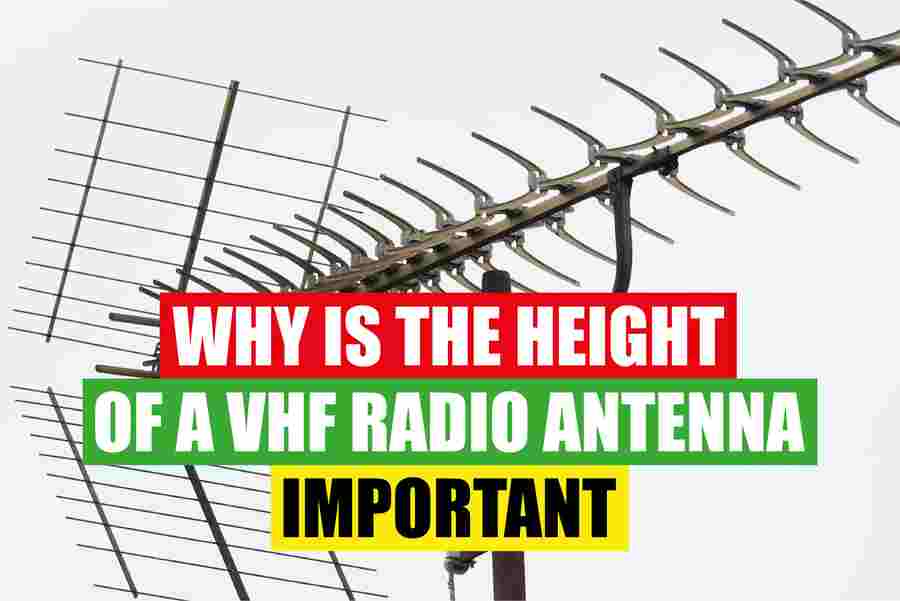Have you ever wondered why the height of a VHF radio antenna is so important? Well, there are many factors to consider when selecting the right antenna for your needs. The height of the antenna is significant because it will determine how far and how well the signal will travel. Additionally, the height of the antenna can affect the signal strength and the overall performance of the radio. It’s important to select an appropriate antenna for the frequency you will be using and to understand the pros and cons of each type of antenna. In this article, we will discuss why the height of a VHF radio antenna is important and the different factors that should be taken into consideration.
Why Is The Height Of A VHF Radio Antenna Important?
The height of your antenna can have a big impact on the way your VHF radio system performs. The higher the antenna is, the more range you will receive and the more area you will cover. The range of your VHF radio system will depend on its height, the terrain and obstacles it will have to go around, and the frequency. The higher your antenna is, it will be able to see over shorter obstructions, so your signal will travel farther.
Types Of VHF Radio Antennas
- Whip Antennas – These are the most common type of VHF radio antenna and are usually mounted on deck level. They are the simplest and least expensive type of antenna, but they have a limited range.
- Collinear Antennas – These antennas are more powerful than whip antennas, as they have multiple elements stacked on top of each other to increase the gain. They can be mounted either vertically or horizontally and can provide greater range than whip antennas.
- Yagi Antennas – Yagi antennas are directional and can provide greater range than a whip or collinear antennas, but they must be pointed at the intended recipient for maximum performance.
- Log Periodic Antennas – These antennas have multiple elements arranged in a logarithmic pattern and have a wide frequency range, making them ideal for multi-band applications.
- Dipole Antennas – Dipole antennas consist of two elements that are spaced apart from each other and are often used for base station applications. They can provide greater range than a whip antenna but have a limited frequency range.
- Helical Antennas – These antennas consist of one or more coils of wire and are usually mounted vertically on the mast or deck level. They have a wide frequency range and can provide a greater range than other types of antennas, but they require more maintenance due to their complex design.
- J-Pole Antennas – These antennas are also called “slim jims” due to their slender design and are often used for mobile applications. They are relatively easy to construct and can provide good performance in the VHF frequency range.
- Ground Plane Antennas – These antennas consist of a vertical element surrounded by four horizontal elements that create an electrical field around the antenna, which increases its gain and efficiency.
- Loop Antennas – Loop antennas consist of one or more loops of wire that can be mounted either horizontally or vertically. They are relatively easy to construct and can provide good performance in the VHF frequency range.
- Quad Antennas – Quad antennas consist of four elements arranged in a square pattern and are often used for multi-band applications. They have a wide frequency range and can provide excellent performance, but they require more maintenance due to their complex design.
Pros And Cons Of Different Types Of Antennas
Whip Antennas – Pros: Easy to install, relatively inexpensive, can provide good performance in the VHF frequency range. Cons: Limited range and directional capabilities.
Collinear Antennas – Pros: Can provide greater range than whip antennas and can be mounted either vertically or horizontally. Cons: They are more expensive than whip antennas and require more maintenance due to their complex design.
Yagi Antennas – Pros: Directional and can provide greater range than whip or collinear antennas. Cons: They need to be pointed at the intended recipient for maximum performance and require more maintenance due to their complex design.
Log Periodic Antennas – Pros: Wide frequency range, ideal for multi-band applications. Cons: Expensive, require more maintenance due to their complex design, and need to be pointed at the intended recipient for maximum performance.
Dipole Antennas – Pros: Greater range than a whip antenna but have a limited frequency range. Cons: They need to be pointed at the intended recipient for maximum performance and require more maintenance due to their complex design.
J-Pole Antennas – Pros: Easy to construct, relatively inexpensive, can provide good performance in the VHF frequency range. Cons: Limited range and directional capabilities.
Ground Plane Antennas – Pros: Increased gain and efficiency due to the electrical field created around the antenna. Cons: More expensive than other antennas and require more maintenance due to their complex design.
Loop Antennas – Pros: Relatively easy to construct, can provide good performance in the VHF frequency range. Cons: Limited range and directional capabilities.
Factors To Consider When Choosing An Antenna
- Frequency Range – The frequency range of the antenna should match your needs.
- Directional Capabilities – Directional antennas are best for long-range applications, while omnidirectional antennas are better for short-range applications.
- Cost – Consider the cost of the antenna and any required installation or maintenance costs.
- Maintenance Requirements – Some antennas require more maintenance than others due to their complex design.
- Size & Weight – Consider the size and weight of the antenna when determining where it can be installed.
Conclusion
The height of a VHF radio antenna is important because it will determine how far and how well the signal will travel. Additionally, the height of the antenna can affect the signal strength and the overall performance of the radio. It’s important to select an antenna that is appropriate for the frequency.

